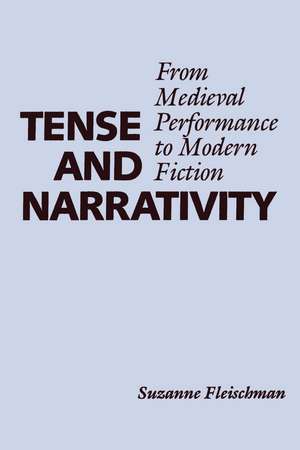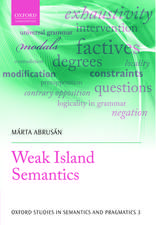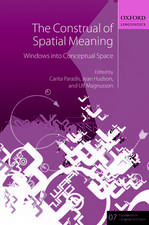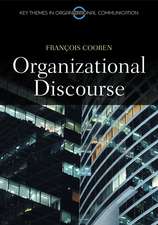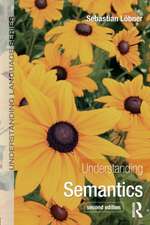Tense and Narrativity: From Medieval Performance to Modern Fiction: Texas Linguistics Series
Autor Suzanne Fleischmanen Limba Engleză Paperback – mar 1990
Fleischman sees linguistics as laying the foundation for all narratological study, since it offers insight into how narratives are constructed in their most primary context: everyday speech. She uses a linguistic model designed for "natural" narrative to explicate the organizational structure of "artificial" narrative texts, primarily from the Middle Ages and the postmodern period, whose seemingly idiosyncratic use of tenses has long perplexed those who study them. Fleischman develops a functional theory of tense and aspect in narrative that accounts for the wide variety of functions—pragmatic as well as grammatical—that these two categories of grammar are called upon to perform in the linguistic economy of a narration.
Din seria Texas Linguistics Series
-
 Preț: 430.34 lei
Preț: 430.34 lei -
 Preț: 262.40 lei
Preț: 262.40 lei - 23%
 Preț: 445.00 lei
Preț: 445.00 lei -
 Preț: 166.47 lei
Preț: 166.47 lei -
 Preț: 277.16 lei
Preț: 277.16 lei -
 Preț: 166.47 lei
Preț: 166.47 lei
Preț: 341.43 lei
Nou
Puncte Express: 512
Preț estimativ în valută:
65.34€ • 67.80$ • 54.61£
65.34€ • 67.80$ • 54.61£
Carte tipărită la comandă
Livrare economică 15-29 martie
Preluare comenzi: 021 569.72.76
Specificații
ISBN-13: 9780292737266
ISBN-10: 0292737262
Pagini: 459
Dimensiuni: 152 x 229 x 30 mm
Greutate: 0.45 kg
Editura: University of Texas Press
Colecția University of Texas Press
Seria Texas Linguistics Series
ISBN-10: 0292737262
Pagini: 459
Dimensiuni: 152 x 229 x 30 mm
Greutate: 0.45 kg
Editura: University of Texas Press
Colecția University of Texas Press
Seria Texas Linguistics Series
Notă biografică
Suzanne Fleischman (1948–2000) was Professor of French and Romance Philology at the University of California.
Cuprins
- Abbreviations
- Preface
- Introduction
- Chapter 1. Working Definitions and Operational Preliminaries
- 1.1. Tense
- 1.2. Aspect
- 1.3. Situation types
- 1.4. Grammar, discourse, and the meaning of tense-aspect categories
- 1.5. Tenses of the past system
- 1.6. Tenses of the present system
- 1.7. Tense-aspect in early Romance
- Chapter 2. A Theory of Tense-Aspect in Narrative Based on Markedness
- 2.1. The concept of markedness
- 2.2. Markedness and tense-aspect categories in narrative
- Chapter 3. “Ungrammatical” Tenses: Background of the Question
- 3.1. Scope of the phenomenon
- 3.2. Diegetic and mimetic discourse
- 3.3. Grammatical “freedom” of the early vernaculars
- 3.4. Tense alternation as a mark of “literary” écritures
- 3.5. Prosodic considerations
- 3.6. Aspectual hypotheses and “situation types”
- 3.7. The HISTORICAL PRESENT: The “past-more-vivid”
- 3.8. The NARRATIVE PRESENT, HISTORICAL PRESENT, and PRESENT tense
- 3.9. Participant tracking
- 3.10. From oral performance to écriture: Oral residue in written texts
- 3.11. Performed stories: Medieval and modern, natural and artificial
- Chapter 4. Narrative Discourse: Typological Considerations
- 4.1. Verbal representations of experience: Story structure and reality structure
- 4.2. Differentia specifica of narrative textuality
- 4.3. Stories, narratives, and other verbalizations of experience
- 4.4. Narrative fiction
- 4.5. Modes of discourse: “Storytelling” and “communication”
- 4.6. Linguistic marks of storytelling
- 4.7. Tense and aspect as metalinguistic signals of narrative genres
- Chapter 5. The Linguistic Structure of Narrative
- Part I. Temporal Structure
- 5.1. Speaker-now and story-now
- 5.2. Retrospective discourse and prospective time
- 5.3. Iconic sequence and the narrative norm
- Part II. Text Structure
- 5.4. The global structure of narrative
- 5.5. Evaluation
- 5.6. Adapting the natural narrative model to complex narrations
- 5.7. The clausal structure of narrative
- 5.8. Conclusion
- Part I. Temporal Structure
- Chapter 6. Textual Functions
- Part I. Grounding: The “Texture” of the Text
- 6.1. The foreground-background contrast
- 6.2. Toward a theory of grounding
- 6.3. Grounding and parataxis
- 6.4. Tense-aspect and grounding
- 6.5. Creating cohesion: The chansons de geste
- Part II. Boundary Marking: The “Space” of the Text
- 6.6. Tense switching and the segmentation of narrative texts
- Part III. Information Blocking: The “Tempo” of the Text
- 6.7. “Co-subordinate” nexus
- 6.8. Pacing the discourse
- Part I. Grounding: The “Texture” of the Text
- Chapter 7. Expressive Functions
- 7.1. Point of view and focalization
- 7.2. The Speaker and the experiencer
- 7.3. Free indirect discourse
- 7.4. Interior monologue
- 7.5. Tense, temporality, and focalization
- 7.6. Time, tense, and memory in Proust
- 7.7. Point of view and the PERFECT
- 7.8. Tense-aspect and point of view in natural narration
- 7.9. Conclusion
- Chapter 8. Metalinguistic Functions: Storytelling in the PRESENT
- 8.1. Epic storytelling: Narration without time
- 8.2. Romancero: The fragmenting of narrative
- 8.3. The HISTORICAL PRESENT and beyond
- 8.4. Transformations of narration in the nouveau roman
- 8.5. PRESENT-tense fiction: Where is it moving?
- Conclusion
- Appendix 1. Coding Conventions
- Appendix 2. Texts
- Notes
- References
- I. Texts Cited
- II. Critical Works
- Concept and Name Index
- Index of Texts Cited
Recenzii
...Fleischman’s book takes the study of medieval literature to new hermeneutic horizons.... Furthermore, through the use of sociolinguistics she connects the modern and medieval worlds in a way that will make the medieval world less alien to us, and thus her perspective gives us another means by which we can make medieval literature more relevant to our students.
Descriere
Fleischman brings together theory and methodology from various quarters to shed important new light on the linguistic structure of narrative, a primary and universal device for translating our experiences into language.
